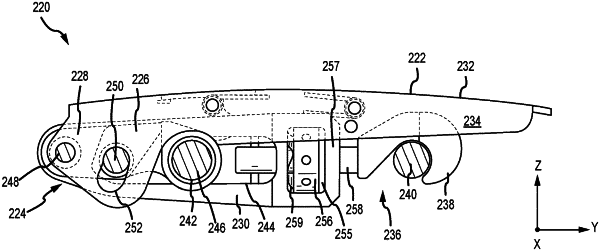| CPC E05C 19/145 (2013.01) [B64D 29/06 (2013.01); E05B 63/0056 (2013.01); Y10T 292/0917 (2015.04)] | 20 Claims |

|
1. A latch mechanism, comprising:
a hook body, the hook body having a hook body load bearing plate;
a hook mechanism, the hook mechanism having a hook and a shaft connected to the hook, the shaft defining a longitudinal axis with respect to the hook body;
an adjustment mechanism configured to adjust an axial position of the hook with respect to the hook body; and
a bearing block, the bearing block having a block load bearing plate disposed between the adjustment mechanism and the hook body load bearing plate, the bearing block including a first boss configured for engagement with the adjustment mechanism;
wherein the bearing block further comprises the first boss at an aft location configured to engage a recess that extends in an axial direction along the longitudinal axis into a first side of an adjustment nut of the adjustment mechanism and a second boss at a forward location configured to engage a plate aperture that extends axially through the hook body load bearing plate of the hook body;
wherein the adjustment mechanism is locked or maintained in a position by a lock mechanism defined by a protrusion and an aperture with respect to the bearing block and that selectively prevents rotation of the adjustment nut about the longitudinal axis wherein a sliding-fit tolerance between an inner diameter of the recess and an outer diameter of the first boss permits a set of associated components comprising the bearing block and the adjustment nut to remain tightly and precisely aligned in the axial direction along the longitudinal axis with minimal ability to move with respect to one another in a lateral direction with respect to the longitudinal axis.
|
|
11. A latch mechanism for an aircraft panel, comprising:
a hook body, the hook body including a plurality of longitudinal members, each of the plurality of longitudinal members extending in an axial direction with respect to the hook body, the hook body further having a hook body load bearing plate connected to the plurality of longitudinal members and being oriented perpendicular to the axial direction;
a hook mechanism, the hook mechanism having a hook and a shaft connected to the hook, the shaft extending in the axial direction with respect to the hook body;
an adjustment mechanism configured to adjust an axial position of the hook with respect to the hook body; and
a bearing block, the bearing block having a block load bearing plate disposed between the adjustment mechanism and the hook body load bearing plate;
wherein the bearing block further comprises a first boss at an aft location configured to engage a recess that extends in the axial direction along a longitudinal axis into a first side of an adjustment nut of the adjustment mechanism and a second boss at a forward location configured to engage a plate aperture that extends axially through the hook body load bearing plate of the hook body;
wherein the adjustment mechanism is locked or maintained in a position by a lock mechanism defined by a protrusion and an aperture with respect to the bearing block and that selectively prevents rotation of the adjustment nut about the longitudinal axis wherein a sliding-fit tolerance between an inner diameter of the recess and an outer diameter of the first boss permits a set of associated components comprising the bearing block and the adjustment nut to remain tightly and precisely aligned in the axial direction along the longitudinal axis with minimal ability to move with respect to one another in a lateral direction with respect to the longitudinal axis.
|